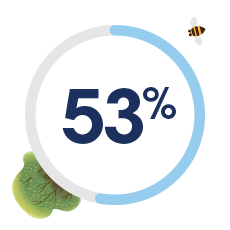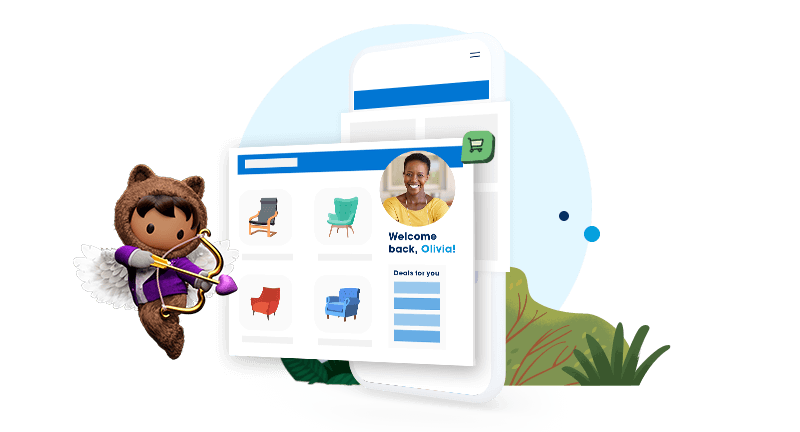How to Take Emotional Loyalty from Concept to Practice in Your Business
Loyalty is no longer a simple matter of offering points and discounts. It’s about saying, “We understand you. We’re here to support you, no matter what you need or when you need it.”
Most loyalty initiatives have focused on transactional rewards — earning enough points for a free coffee is a classic example. But there’s an emotional element at play in order to build long-term relationships. The brands that forge emotional connections with customers are able to create experiences that demonstrate they understand their priorities and preferences. In fact, more than half of customers (53%) today say they feel an emotional connection with the brands they buy from the most.

53% of customers say they feel an emotional connection with the brands they buy from the most.
Meanwhile, brands that only offer transactional benefits run the risk of customers switching to competitors with similar rewards. Excitement over initial perks wears off over time and the experience is not differentiated enough to keep the customer loyal. Think about it this way: If a restaurant’s rewards program includes a free beverage with every meal, what happens when a competitor starts offering the same — or a better — deal? What makes the customer continue to choose the first restaurant?
If a brand builds an emotional connection, the customer has more of a reason to continue choosing them time and again – even if there aren’t bonus points and rewards tied to every transaction. While transactional rewards are a way to acquire customers – and even act as a tool to compensate customers for a poor experience – it’s the overarching brand experience that keeps customers coming back. That means loyalty is a matter of striking the right balance of rational and emotional benefits to build a long-term relationship.
Sounds easy enough, right? Most brands tend to get the rational part right, but they miss the mark on the emotional aspect — and they don’t even realize it. Consider that executives believe they understand consumers’ emotions, but only 15% of consumers agree.
While loyalty is earned over time, you can start the journey and build emotional connections now to ensure that you’re the customer’s No. 1 choice every time. It may feel abstract, but with the right tactics, you can turn emotional loyalty from a concept to a practice for your business. Here are the specific ways to build emotional connections with your customers.

What is emotional loyalty?
Emotional loyalty is the culmination of moments that are meaningful to your customer. It means that brands need to make customers feel valued during every interaction.
To do this, brands must offer customers more than purchase-based rewards for their business. They must find opportunities to strengthen connections throughout the entire customer experience. In other words, although customers are happy to earn rewards leading to a special deal, that becomes a byproduct of the collective brand experience, according to Brian Solis, Global Innovation Evangelist, Salesforce.
AAA Carolinas is a prime example of a brand that built an emotional connection that drove loyalty. In the beginning of the COVID-19 pandemic, AAA Carolinas identified older customers who were likely to be living alone. Agents called these customers, thanked them for their business, and asked if they needed anything. Customers responded by asking for help getting essential items, like cleaning supplies, when they couldn’t get to the store. AAA Carolinas delivered on the ask by dropping off those items at their doorstep. Because of this very human reaction, the customer response was incredible and renewal rates are at an all-time high.
But it doesn’t have to take a moment of crisis to respond in this way. Brands have a treasure trove of data that they can use to anticipate and respond to changing customer needs. This data helps them detect new buying behaviors and deliver the most relevant, personalized experiences at every interaction, which delights customers and shows them that the brand has their back. This strengthens the emotional connection and makes customers more inclined to go out of their way to do business with them. Sixty percent of long-term customers will even use emotional language — like “love” and “excited” — to describe their connection to favored brands. Customers will also be more inclined to recommend the brand to their friends and family based on the experience.
How emotional loyalty affects buying decisions
It used to be that customers began engaging with brands at a rational level. They were motivated by the product, price, or convenience. As the relationship evolved, emotional factors surfaced that impacted how they felt about the brand. Today, with increased expectations on brands and more options than ever before, customers are using their emotions to guide buying behaviors.
Brands need to focus on the emotional elements at the onset to build connections over time. If needs aren’t met – whether it’s during a frustrating service interaction or through irrelevant, generic brand communications – the relationship starts to fray. When this happens, customers switch back to rational decision-making – and use reasons like convenience, product, and price to end the relationship and explore a competitor’s products.
Brands always need to think about how to get a customer’s attention, business, and repeat business while building a relationship that can weather any challenge. This requires a mix of emotional and rational benefits that meet the following criteria:
Consistency
Experiences
Personalization

“How someone feels after each engagement is essentially a step toward or a step away from emotional loyalty.”
– Brian Solis, Global Innovation Evangelist, Salesforce
To further illustrate the concept, think about sports: Most fans already have a longstanding emotional connection with their favorite team. Their family members are fans, they grew up going to games, or their team won a championship. Fans will weather disappointments in the relationship — losing streaks, missing the playoffs, or the trade of a popular player — without ditching their team because of the long-standing emotional connection.
The same sentiment applies to the brand relationship. If a company creates a strong emotional connection, the customer is far less likely to churn because of a single bad experience. But identifying the right tactics to replicate this sentiment has historically been hard for brands.

7 tactics to put emotional loyalty into practice for your business
Most brands struggle to deliver on the emotional aspects that build long-term relationships. That may be because the brand is still product-centric, doesn’t view itself or its products as something a customer would form an emotional connection with, or has difficulty building an actionable plan to foster emotional loyalty.
Below are seven tactics that can help you turn emotional loyalty from a concept into a practice in your business.
1. Put your customer first
Before you can consider the right emotional benefits, you have to take a step back and think about your customer. By putting the customer at the center of every decision, you are able to take every opportunity to delight them — whether it’s in a sales interaction or service experience. These moments of delight ultimately build a bond with customers that can weather challenges.
You need to empower all employees to become customer-centric, including teams that are traditionally not accustomed to owning the customer experience – like accounting and operations – but can directly (or indirectly) impact it. Consider that if a customer reaches out with a pricing issue, your service team needs to work with finance quickly to resolve the problem.
Put in place employee training programs, including an ongoing workshop series and digital learning paths, to help front-line staff deliver meaningful experiences during interactions. Teach a mix of soft and hard skills, like communications basics and how to use the technology. Put in place a governance strategy for processes – including those moments when front-line staff must engage back-end operations to resolve a problem. Define new key performance indicators (KPIs) for teams to assess their success. And ensure leadership regularly sends out communications on everyone’s responsibility to drive loyalty.
2. Embed loyalty into the entire customer experience
Loyalty needs to become an organization-wide initiative, not just a marketing-owned strategy. Team members from marketing, service, commerce, and operations need access to real-time customer data. Even teams that don’t interact directly with customers, such as analytics, finance, and accounting, should buy in and share the critical insights that impact customer loyalty. This requires shared technology systems that pull in multiple data sources to give teams the right insights to engage customers and drive value to the business.
A single source of truth for data will help your brand deliver personalized, consistent experiences in any interaction. Salesforce Loyalty Management allows you to manage your loyalty program with both your CRM data and your loyalty data – plus data from third-party sources – to create those experiences. Whenever a customer reaches out, all team members have the data they need to drive loyalty.
Learn how to move from transactionally focused loyalty programs to human-centric experiences that increase customer lifetime value.
3. Understand needs across the customer lifecycle
A critical component to emotional loyalty is making every interaction feel relevant and personalized. It also means anticipating fluctuations in the relationship over time.
A unified view of CRM and loyalty data allows you to deliver the most personalized experiences for each member. You can tie your data sources to your loyalty program so that data is unified with everything else you know about the customer.
With Salesforce’s customer data platform, you can create and update your segments based on browsing history and purchase habits. You can also track behaviors across different data sources. This data will help you detect the kinds of communications and rewards that are most relevant to customers at any given time.
4. Diversify your loyalty program benefits
Some customers prefer discounts or extra points. Others love access to exclusive events and classes or the ability to redeem rewards in the form of charitable donations. The key is to understand your customers’ preferences so you can match them with the right mix of incentives.
With Loyalty Management, you can assign benefits based on a tier or member behavior. Benefits can range from a point multiplier to premiere customer support. For example, when a customer engages with a chatbot on your website with a service issue, the bot can recognize their tier in your loyalty program. The bot then pushes the customer to a live agent, bypassing the service queue and enabling personalized one-on-one support for high-value members.
5. Give customers an easy way to interact with your loyalty program
6. Show customers you’re listening
7. Use customer insights to keep members engaged
It’s important to understand how members interact with your program and use what you know about them to improve engagement. For example, does a customer only stay at your hotel during the work week for business, but otherwise chooses a competitor for personal travel? Your data can help you find the right mix of benefits to convert weekday business travelers into loyal vacationers.
Tableau CRM offers predictive analytics to help you spot potential disengagement and reduce member churn. Based on your insights, you can determine the right rewards to re-engage members. You may choose to segment members based on preferences and customer lifetime value. One group may receive an email that includes relevant products and an incentive to earn more points. Another may get an invitation to an invite-only event that makes them excited again to interact with your brand.
How a leading retailer balances rational and emotional benefits
Now that you know the tactics, let’s look at a real-world example of emotional loyalty. Leading U.K. and Ireland fashion footwear retailer schuh realized that they needed to deliver more than just discounts to increase customer lifetime value. So the brand built a loyalty program that offers VIP experiences and exclusive perks aligned to their brand values to its most loyal members.
Program members qualify for discounts, access to special promotional events, and other perks that make them feel special and a part of a community. With this program, schuh is able to build both a rational connection through points and an emotional connection through exclusive perks and events..
How to get started
Discover Salesforce Loyalty Management
- Make loyalty an organization-wide initiative
- Embed loyalty into every part of the customer experience
- Engage customers in meaningful ways that build lifetime relationships

Article
Why Your Customer Loyalty Program Isn’t Profitable – and How To Fix It

Blog
Customer Loyalty Is Up for Grabs: Why Your Strategy Is Critical

Article
The Retailer’s Guide to Customer Loyalty
More resources

Loyalty Beyond Discounts: How Manufacturers Can Engage Channel Partners

B2C Loyalty Management Demo Video




